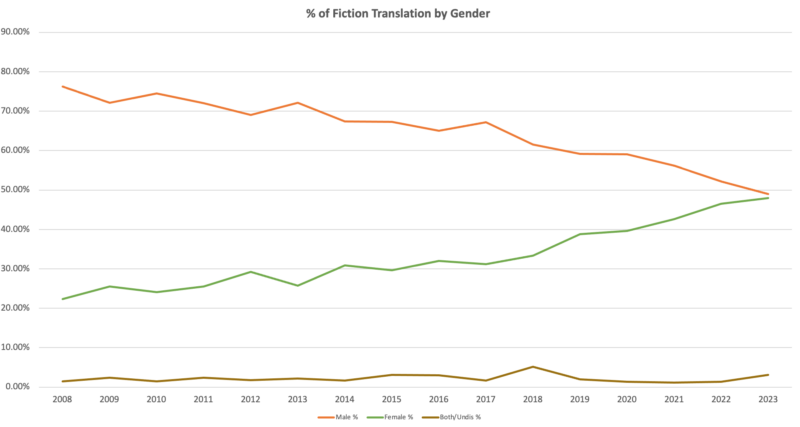The Visual Success of Women in Translation Month [Translation Database]
Women in Translation Month is EVERYWHERE.
Whenever I open Twitter (or X?), my feed is wall-to-wall WIT Month. Tweets with pictures of books to read for WIT Month, links to articles about WIT Month and various sub-genre lists of books to read during WIT Month, general celebratory tweets in praise of Meytal Radzinski for founding WIT Month, announcements of WIT Month related events (seemingly a few a day), publisher promotions for their WIT titles, and tweets talking about how all the tweeter can talk about is WIT Month. The sheer volume of tweets and retweets and responses to earlier WIT Month is— it’s, it’s just wild.
It’s at the point that being on Twitter doesn’t even make me mad! WIT Month has, at least temporarily, washed away so much of the rage and insanity from my feed. It’s wonderful. If this is what the “death of Twitter” looks like, I’m on board.
Anyway, you’d be hard pressed to find anyone who wouldn’t agree that, anecdotally at least, Women in Translation Month has been a smashing success. It’s got such great online buzz. Presses pay attention and help promote it in a variety of ways. Bookstores and readers join in. The Warwick Prize for Women in Translation was inspired by WIT Month. Across all those metrics—word-of-mouth, raising awareness, getting attention for the cause and the books—WIT Month has been an unquestionable hit.
And, at least according to the data in the Translation Database, this isn’t just anecdotal: there’s been a huge shift in the makeup of literature in translation since 2014.
Before sitting down to run the numbers and write this post, my sense was that there are more and more books by women coming out in translation all the time. Just within Open Letter, we’re publishing more women in translation than ever, what with three Dubravka Ugresic books coming over the course of a year, the all-female Translator Triptychs from Katie Whittemore and Janet Hong, etc.
And, thanks to the Translation Database, this is really easy to prove.
I started by looking at the number of works of fiction or poetry written by women published between 2008 and 2023, but on it’s own, these numbers are of limited interest. It is fun to see the huge jump between the number of translated works of fiction by women published in 2008 (only 63) and in 2016 (182 works by women), but between 2014 and 2021 the numbers are pretty stable.
What’s really illuminating though—and kind of mind-blowing—is the clear and steady increase in the percentage of books written by women. In 2008, when we first started collecting data, 76% of all published works of fiction in translation were written by men. Only 22% by women. That’s a massive gap. Three out of every four translations were written by a man. Accessibility has a huge influence on what gets onto the shelves in bookstores, what gets reviews, which books dominate the general discourse, etc.
Looking at this chart, there’s no question that WIT Month has had a giant impact. In 2013, the year before WIT Month launched, only 26% of the works of translated fiction published were written by women. In 2022, that number was 47%.

A decade ago, it seemed inconceivable that there would be an almost equal percentage of books written by men and women coming out in translation in a given year. And yet . . . I’m truly astonished. To be able to see the impact of a program this clearly is incredible.
Kudos to Meytal and to everyone who has been supporting WITMonth over the past decade. It’s literally changed the shape of our reading culture for the better.
*
Over the next few weeks, I’ll be adding as many books as possible to the Translation Database and doing some general clean up. So if you have a book that’s missing from the database and needs to be added, please fill out this form. Same form if you see a listing with a typo or other error. Thanks for your help!

Leave a Reply